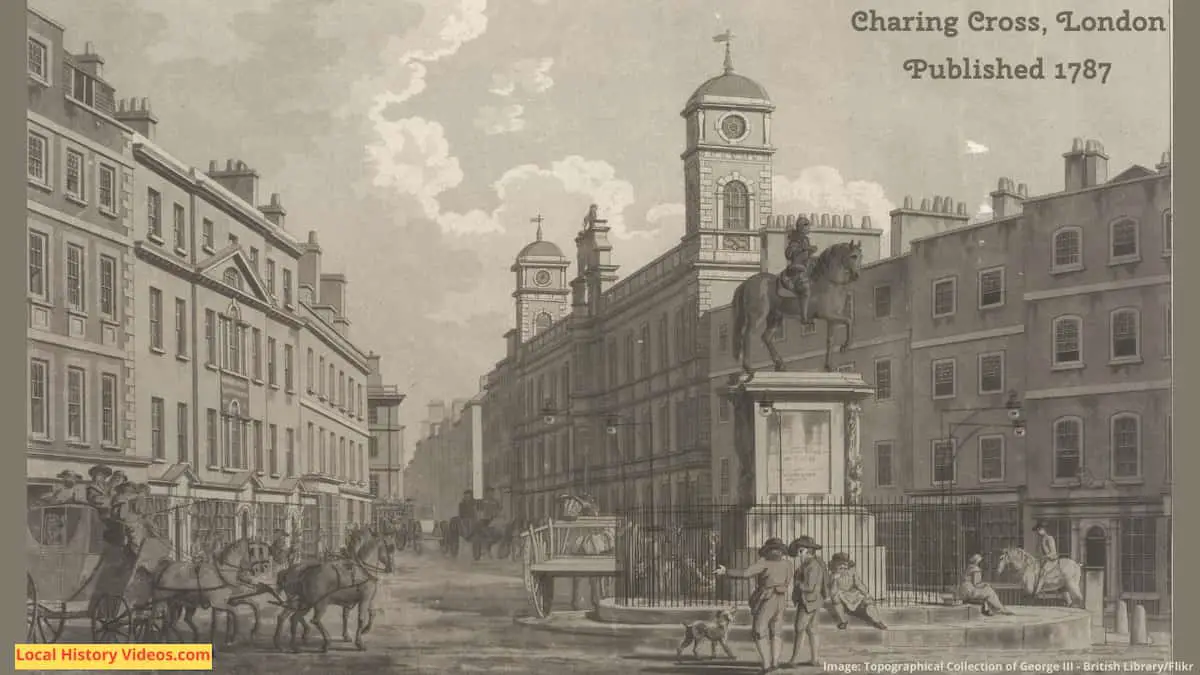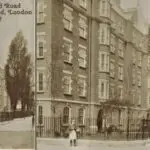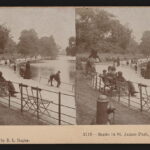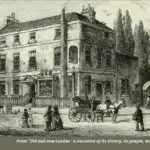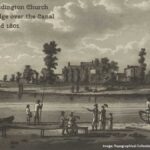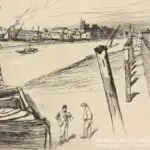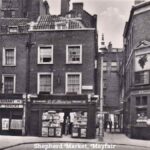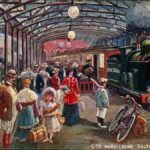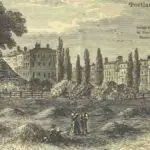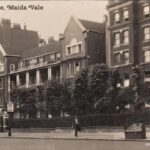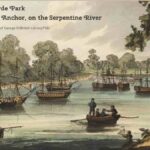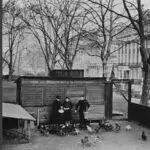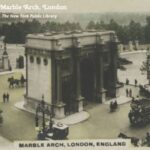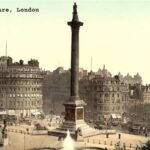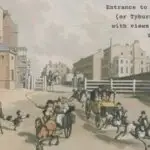Glimpse history through old images of Charing Cross in the City of Westminster, London.
How did Charing Cross get its name?
In old English, cierring meant a river bend. Thats probably how the original hamlet of Charing got its name. In 1291-94, King Edward I had the stone Eleanor Cross made by Alexander of Abingdon, as a memorial to his late wife, Eleanor of Castile.

The Eleanor Cross was destroyed by Parliamentarians in 1647, during the the years of the English Civil War.
In 1675, a statue of King Charles I, mounted on a horse, was placed on the site of the Eleanor Cross, and has stood there since.
A reimagining of the medieval cross was placed at Charing Cross railway station in 1865, with the railway station named after the famous monument.
The Victorian statue is sited 203 metres north-east of the former Eleanor Cross position. Designed at the time of the Gothic Revival movement, it’s larger and more elaborate than the original cross, too.
Charing Cross Road was named after the railway station.
General Haig (1918)
Prseumably this silent, black and white footage from 1918 was recorded at the end of the Great War, later known as World War I.
It shows the streets outside the Bureau de Change and the J.Lyons teahouse crowded with people, as General Haig passes through as part of a procession of horse driven open top carriages, with a car at the end.
Dignitary arrives in England to crowds of people (1918) – British Pathé on YouTube
Traffic (1926)
Silent, black and white footage recorded in 1926 shows the streets of Charing Cross and Piccadilly clogged with traffic.
The situation is precarious, with pedestrians weaving through the path of oncoming buses, vans and cars. The men and young boys pushing handcarts loaded with goods sometimes haveto run as fast as they can to get to safety.
Even stationary buses are a hazard, as pedestrians suddenly pop out between them to cross the road, giving little warning to the vehicles approaching from the other direction.
Driving licences were introduced in the UK in June 1935, still a decade away from these chaotic scenes.
Traffic at Charing Cross and Piccadilly (1926) – British Pathé on YouTube
Underground Crash (1938)
On 17th May 1938, at 9:55 a.m., an inner circle train crashed into a stationery district train in the London Underground tunnel, eastbound between Charing Cross and Temple Station.
It was later established was that a wiring error had caused a signal fault, meaning the moving vehicle had received a green light to proceed into the area where the stationary train waited at a second, red signal.
Six passengers were killed, or died in hospital shortly after the accident. 43 passengers and two of the trainmen received injuries, or complained of shock at the time, with 33 receiving hospital treatment. 14 of them stayed in hospital overnight, of which half of them were still in hospital a week later. One of the Board’s officers received electrical burns shortly after the accident.
It was, at that point, the worst accident in the history of the London Underground.
The black and white newsreel shows the rescue efforts at Charing Cross Underground station. Fire engines, ambulances, the police in capes, and transport workers were out in force. A nearby bridge is crowded with spectators, watching as the dead and injured are carried out of the station on stretchers.
Deadly Underground train collision between Charing Cross and Temple Station in London (1938) – British Pathé on YouTube
Charing Cross Road (1940)
In 1940, a bomb crater left the road unusable. So the Royal Engineers constructed a wooden bridge, opened by Mr W A Foyle on 9th November 1940, known as Foyle Bridge.
It allowed buses, cars, cyclists and pedestrians to go about their normal business, despite the huge hole beneath them. A soldier sat in a signal box, so vehicles took turns gaining access to the single lane bridge.
Silent footage records this substantial wartime damage and the efforts to carry on as normal. In the background are lots of buildings and businesses, as well as quite a few people.
Charing Cross Road Crater (1940) – British Pathé on YouTube
Fog Service (1948)
The London smog was a notorious health hazard which is known to have cost thousands of lives. In Charing Cross station signs were put up saying ‘Fog Service in Operation’.
Foggy London Town (1948) – British Pathé on YouTube
Charing Cross Road Fire (1948)
This silent film clip shows firefighters battling a blaze.
We also see lots of local people, some of them smiling cheerfully at the camera, being held back by the police.
Then there are shots down Charing Cross Road, so you can see many buildings.
The firefighters then end up tackiling the blaze from the rooftops.
Fire In Charing Cross Road (1948) – British Pathé on YouTube
Waterman (1949)
In 1949, Bob Woods sat in a small boat under Charing Cross bridge, ready to rescue any workmen who fell from their labours above. He had to keep rowing because of the tides, except when the workmen stopped for lunch.
Waterman (1949) – British Pathé on YouTube
Charing Cross Station (1965)
In 1965, Charing Cross station allowed a carpet manufacturer to lay a carpet at the station for a month, displaying its ability to withstand being walked over by thousands of arriving and departing passengers.
Beyond the curiosity value, this footage is great for its shots of the front and interior of the railway station, showing the facilities, businesses, and passengers of 1965.
Commuters On The Carpet (1965) – British Pathé on YouTube
1970s Hostel Plan
Even in the early 1970s, the rising number of homeless people sleeping on London’s streets next to empty buildings was causing concern.
One plan was to convert the almost disused Charing Cross Hospital, just off The Strand, into a shelter for the homeless. At the time, only about 40 patients remained in the large and elegant building, because in 1973 Charing Cross hospital was transferred to Fulham Palace Road in Hammersmith, in west London.
Interviews include campaigner Alastair Miller, and homeless people sleeping rough at the Marmite factory.
One man explains that he was born in South Wales in 1938, in a working class family. He became a trained musician and a composer by profession, also working as a pianist and organist. He was sleeping rough because of “a very serious drinking problem”.
We also hear from the spokeperson for the Covent Garden community, explaining why local residents objected to the hostel scheme. He says that there are already two large ‘doss houses’ in the area, one a Drury Lane and one in Parker Street. He feels there are ever increasing numbers of homeless people in the area, as the number of residents falls rapidly, leading to an imbalance. His references to council services breaking down reflects a lot of social turmoil of the period.
Today, the elegant Victorian building is home to the Charing Cross police station.
Charing Cross Hospital (1970-1979) – British Pathé on YouTube
Charing Cross Station
This brief footage of commuters coming out of the station, and passengers gettin on a bus, was probably filmed in the 1990s given the cars and clothing we see.
COMMUTERS: Charing Cross Station – Thames News on YouTube
A Bit of Charing Cross History
Extract from “Old and new London: a narrative of its history, its people and its places, by W. Thornbury (E. Walford) ”, by George Walter Thornbury & Edward Walford
Published in 1880
Pages 123 – 134
CHARING CROSS, as every Londoner knows, is the name given to the open space at the western end of the Strand, from which Whitehall, Cockspur Street, and St. Martin’s Lane branch off in different directions; but of late years a considerable portion of it has been absorbed in what is now called Trafalgar Square.
The name is most probably derived from the old village of Charing, which stood here, a sort of halting – place in bygone times, for travellers between the cities of London and Westminster; though some fanciful writers have sought its derivation in the words chère reine, alluding to the cross which was here set up by Edward I. in memory of his ” dear Queen ” Eleanor.
The latter, as every reader of a child’s History of England knows, accompanied Edward I. to the Holy Land, where, on his “being wounded by a certain Moor with a poisoned dagger, and rather growing worse than better by the applications of his physicians, she administered a new and unheard – of remedy. Full of affection and duty, she daily licked the wound which the force of the poison prevented from closing, and sucked out the deadly matter. By dint of this, or, to speak more truly, by the power of conjugal affection, she so drew out the noxious matter, that the wound healing, the king perfectly recovered, and she received not the least harm.”
It is well known that wherever her bier rested, as at Waltham, Tottenham, and other places, her sorrowful husband erected a cross, or, as Tom Hood whimsically said, in his usual punning vein, apropos of the cross at Tottenham:
” A royal game of fox and goose,
To play for such a loss;
Wherever she put down her orts,
There he set up a cross ! “
The original cross was of wood, wholly or to a great extent; but it was built in stone by Richard, and, after his death, by a son or brother, Roger de Crundale. The material used was Caen stone, and the steps were of fine smooth marble. It appears to have been of an octagonal form, and, in an upper stage, ornamented with eight figures.
On Aggas ‘ map is shown a small house occupying the spot where the equestrian statue of Charles I. now stands. This may possibly have been an erection known as the Hermitage, described otherwise as ” a small chapel dedicated to St. Catharine, which stood over against the cross.
” This cross, ” says Stow, ” builded of stone, was of old time a fair piece of work, there made by command of Edward I. ” Mr. Newton, in his ” London in the Olden Time, ” tells us that it “appears to have been more elegant than any of the other eight crosses erected to Queen Eleanor’s memory. It was of Caen stone, beautifully wrought with many figures, and raised upon steps of marble. ” He also subsequently styles it a ” superb piece of architecture. “
The cross itself was sentenced by the Parliament to be taken down in 1643, but its actual demolition was not carried out till some four years later, namely, in the summer of 1647.
Lilly, in his ” Observations on the Life of King Charles I., “published in 1715, says that part of the stones of which it was composed were employed in paving the front of Whitehall, whilst other stones were made into knife – hafts and other articles, which, when polished, looked like marble.
The following lines on the downfall of the cross itself, which are quoted from “Percy’s Reliques”, are interesting and amusing:
” Undone, undone the lawyers are;
They wander about the towne;
Nor can find the way to Westmi
Now Charing Cross is downe:
At the end of the Strand they made a stand,
Swearing they are at a loss,
And, chaffing, say, that’s not the way
They must go by Charing Cross.
” The Parliament to vote it down
Conceived it very fitting.
For fear it should fall and kill them all,
In the house as they were sitting.
They were told, God wot, it had a plot,
Which made them so hard – hearted,
To give command it should not stand,
But be taken down and carted.
” Men talk of plots; this might have been worse,
For anything I know,
Than that Tomkins and Chaloner
Were hanged for long agoe.
Our Parliament did that prevent,
And wisely them defended;
For plots they will discover still
Before they were intended.
” But neither man, woman, nor child
Will say, I’m confident,
They ever heard it speak one word
Against the Parliament.
An informer swore it letters bore,
Or else it had been free;
I’ll take, in troth, my Bible oath,
It could neither write nor read.
” The committee said, that verily
To Popery it was bent;
For aught I know it might be so,
For to church it never went. *
What with excise, and such device,
The kingdom doth begin
To think you’ll leave ne’er a cross
Without doors nor within.
” Methinks the Common Council should
Of it have taken pity,
‘ Cause, good old cross, it always stood
So firmly to the City.
Since crosses you so much disdain,
Faith, if I were as you,
For fear the king should rule again,
I’d pull down Tyburn too. “
Mr. Wood, in his “Ecclesiastical Antiquities of London,” gives the site of the ancient Hospital of St. Mary of Rounceval (de Roscida valle), at the angle of Whitehall and the Strand, so that no doubt it formed a part of Northumberland House.
Dugdale, in his “Monasticon,” tells us that the original hospital at Charing Cross was founded for the benefit of “lunatic and distracted people,” but that the date of its foundation is not known.
In the year 1554, Charing Cross became the scene of an encounter between the troops of Queen Mary and a band of rebels headed by Sir Thomas Wyatt, who, having taken up arms against the Queen, was advancing against the City. The episode is thus described by the honest chronicler, John Stow – “The same night ( February 6th ), about five of the clock, a trumpeter went about, and warned all horsemen and men – at – arms to be at St. James’s Field; and all footmen also to be there by six of the clock next morning. The Queen’s scout, on his return to the court, declared Wyatt’s being at Brentford, which sudden news made all in the court wonderfully afraid. Drums went through London at four of the clock in the morning, commanding all soldiers to armour, and so to Charing Cross. Wyatt, leaving the Earl of Pembroke, was come into the field. He stood at Knightsbridge until day, when his men rested, being very weary with the travel of the night and day before, and also partly feebled and faint, having received small sustenance since their coming out of Southwark. There was no small ado in London, and likewise the Tower made great preparation of defence. By ten of the clock, the Earl of Pembroke had set his troop of horsemen on the hill in the highway above. St. James’s, his footmen were set in two battles somewhat lower, and nearer Charing Cross, at the lane turning down by the brick wall from Islington – ward (St. Martin’s Lane), where he had also certain other horsemen, and he had planted his ordnance upon a hill – side in the meantime. Wyatt and his company planted his ordnance upon a hill beyond St. James’s, almost over against the Park Corner; and himself, after a few words spoken to his soldiers, came down the old lane on foot, hard by the court gate at St. James’s, with four or five ancients, his men marching in good array. The Earl of Pembroke’s horsemen hovered all the while without moving, until all was passed by saving the tail; upon which they did set, and cut off; the other marched forward in array, and never stayed or returned to the aid of their tail. The great ordnance shot off freshly on both sides. Wyatt’s ordnance overshot the troop of horsemen. The Queen’s whole battle of footmen standing still, Wyatt passed along by the wall towards Charing Cross, where the said horsemen that were there set upon part of them, but were soon forced back. At Charing Cross, there stood Sir John Gage, Lord Chamberlain, with the guard and a number of others, almost a thousand; the which, upon Wyatt’s coming, shot at his company, but at the last fled to the court gates, while certain pursued, and forced with shot to shut the court gate against them. In this repulse, the Lord Chamberlain and others were so amazed that they many cryed treason in the court, and had thought that the Earl of Pembroke, who was assaulting the tail of his enemies, had gone (over) to Wyatt, taking his part against the Queen. There was running and crying out of ladies and gentlemen, shutting of doors and windows, and such a shrieking and a noise as was wonderful to hear. ” The upshot of the affair, however, was that Wyatt surrendered, not being soldier enough to turn his advantage to account.
The bronze equestrian statue of Charles I. at Charing Cross is generally reckoned one of the best of our public statues, and certainly is admirably placed. It was modelled by Hubert Le Sœur, a Frenchman who came to England about the year 1630, and the statue was cast by a commission from the Earl of Arundel, in 1639, ” on a spot of ground hard by Covent Garden Church. ” It was erected just before the beginning of the serious troubles between Charles and the Parliament. A writer in Chambers Fournal thus sums up its history: ” When the hapless monarch was consigned to the block, his statue became as unpopular as himself; accordingly, it was taken down by order of the revolutionary Parliament, and was sold to one Rivers, a brazier, who lived at the Dial near Holborn Conduit, with strict injunctions that it should be broken up. But Rivers was either a royalist or a sly – boots; he kept the statue intact, buried it underground, and drove a brisk trade in knives and forks, with bronze handles, which he pretended were made out of the obnoxious statue. He clearly must have made a good thing out of the knives and forks which he manufactured in bronze for sale, since the Royalists no doubt eagerly bought them as relics of their unfortunate and lamented sovereign, whilst the Puritans and Roundheads would be equally glad to secure them as trophies of the downfall of a despot.“
Long after the season of turmoil, when Charles II. and the Royalists were in power and in fashion, the bronze statue came again forth into light, and was set up in 1674 on its present position. The stone pedestal, sculptured with the royal arms, trophies, & c., was long regarded as the work of Grinling Gibbons; but, if we may believe Mr. John Timbs, a written account is extant, proving it to be by Joshua Marshall, master – mason to the Crown. On the 29th of May the anniversary of the restoration of Charles II. the statue was formerly decorated with boughs of oak.
The poet Waller praised the king and the statue with most courtly panegyric, but Andrew Marvell contrived to make a good deal of fun out of both, and in the following way – Sir Robert Vyner, Lord Mayor of London, about that time had put up an equestrian statue of Charles II. at the Stocks Market, on the spot where the Mansion House now stands; and as Marvell had not much more love for the one than for the other monarch, he wrote a clever satiric dialogue purporting to be held between the two rival horses. Each horse reviled the king who bestrode the other horse the one attacking the profligacy of Charles II., the other the despotic conduct of Charles I. The Charing Cross steed making an attack on the Stocks Market monarch, said, amongst other bitter things, that it was wondrous
” That he should be styled Defender of Faith, ‘
Who believes not a word that the word of God saith. “
And added, in allusion to the current belief that Charles II. had professed himself a Roman Catholic:
” Though changed his religion, I hope he’s so civil
Not to think his own father is gone to the devil. “
It has been said, but we know not with how much of truth, that the sculptor, on finding that he had omitted to put girths to the saddle and trappings of the horse, till it was too late to remedy the defect, put an end to his existence. The omission is stated to have been pointed out by a countryman. Horace Walpole observes of it that ” the commanding grace of the figure and the exquisite form of the horse, are striking even to the most unpractised eye. “
The sword held by Charles, or rather by his statue here, is a modern one. The story of the substitution of the new sword for the old one, which we take from Chambers ‘ ” Book of Days, ” is a strange one – In Notes and Queries for 1850, Mr. Planché asked, ” When did the real sword which, but a few years back, hung at the side of the equestrian statue of King Charles at Charing Cross, disappear ? That the sword was a real one of that period, I state upon the authority of my learned friend, Sir Samuel Meyrick, who had ascertained the fact, and who pointed out to me its loss. ” To this query Mr. Street replied, ” The sword disappeared about the time of the coronation of her present Majesty, when some scaffolding was erected around the statue, which afforded great facilities for removing the rapier – for such it was; and I always understood that it found its way into the so – called museum of the notorious Captain D where, in company with the wand of the Great Wizard of the North, and other well – known articles, it was carefully labelled and numbered, and a little account appended relating the circumstances of its acquisition and removal. ” The editor of Notes and Queries pointedly added to this communication, ” The age of chivalry is certainly past, otherwise the idea of disarming a statue would never have entered the head of any man of arms even in his most frolicsome mood. ” We may conclude then that the present sword of this remarkable statue is a modern substitute.
The pedestal upon which this statue stands is very ornamental. The plinth, formerly of Portland stone, was renewed in granite and slightly raised in 1856; the restoration being made under the superintendence of Sir Gilbert Scott.
The cross was also used for other practical purposes; at its foot royal proclamations were read, and in general any matter of public interest was proclaimed. To this fact Swift alludes:
” And all that passes inter nos
May be proclaimed at Charing Cross. “
Here, also, occasionally culprits stood in the pillory, as being the most public place in the west of the metropolis.
Amongst those who so suffered here was the bookseller, Edmund Curll, who lost his ears on the occasion. His memory is embalmed in the ” Dunciad ” of Pope, as the author of sundry pieces which deserved anything but immortality. He died in 1748.
We may remark here that some of the regicides, including General Harrison, Peters, and Cook, were executed on the very site where the cross had stood; and Wood, in his “Athenae Oxonienses,” adds that Harrison was put to death with his face looking towards the Banqueting House at Whitehall. Pepys, in his ” Diary, ” thus records the event – “Oct. 30, 1660. I went out to Charing Cross to see Major General Harrison hanged, drawn, and quartered; which was done there, he looking as, cheerful as any man could do in that condition. He was presently cut down, and his head and heart shown to the people, at which there was great shouts of joy…. Thus it was my chance to see the king beheaded at Whitehall, and to see the first blood shed in revenge for the king at Charing Cross.“
The fanatic Harrison, we may here observe, was the son of a butcher at Newcastle-under-Lyne, appointed by Cromwell to convey Charles I. from Windsor to Whitehall, in order to stand his trial, on which he sat also as one of the judges.
The two regicides Cook and Peters suffered together; and the body of Harrison having hung the due time, was cut down, and the process of quartering commenced, when, at the suggestion of Colonel Turner, Peters was brought forward that he might be witness of the horrible mutilation. The hangman, rubbing his bloody hands, asked him how he liked it. “I am not terrified; do your worst,” was the reply; and a few minutes later his strangled body was quivering beneath the knife of the executioner. If the accounts of the last moments of the daring men who suffered at this time be true, it will be seen that, whatever crimes might be laid to their charge, the guilt of cowardice could not be imputed to the regicides.
Charing Cross was one of the places most frequented by shows and exhibitions in the days of Charles II. and James II.
In August, 1664, Samuel Pepys writes in his ” Diary: ” ” At Charing Cross, I there saw the great Dutchman that is come over, under whose arm I went with my hat
on, and could not reach higher than his eyebrows with the tips of my fingers. “
It was at the ” Admiral Duncan ” tavern, Charing Cross, that, in March, 1824, the men of Cumberland and Westmoreland in the metropolis met together, and resolved to found the Annual North Country Wrestling Matches, which have ever since that time been celebrated year by year on Good Friday, and which we shall mention more fully hereafter.
We are reminded by the author of “Haunted London” that, in 1666-67, an Italian puppet – player set up his booth at Charing Cross, and probably introduced “Punch” into England. He paid a small rent to the overseers of St. Martin’s parish, and is called in their book, “Punchinello.”
“In 1668,” adds Mr. Cunningham, ” a Mr. Devone erected a small playhouse in the same place.”
In the Harleian MSS. there is still extant a song in rather rugged verse, written to ridicule the long delay in setting up the king’s statue; it is curious as containing an allusion to ” Punch: “
“What can the mystery be that Charing Cross
These five months continues still blinded with board ?
Dear Wheeler impart: we are all at a loss,
Unless Punchinello is to be restored.“
Milton, we are told, lodged at one Thomson’s, next door to the “Bull’s Head Tavern,” at Charing Cross, close to the opening into Spring Gardens, during the time that he was writing his ” Anglia Defensio. “
Thornton, in his ” Survey of London and Westminster, ” published in 1785, tell us that on the north side of Charing Cross there is a large square, on one side of which is a handsome building, used as stabling for his Majesty’s horses, and generally known as the ” Mews, ” or ” Meuse. “
The word is derived, as every antiquary knows, from the ” mew ” of the young of the falcon and hawk tribe. It appears that, as early as the year 1377, this place was used for the purposes of the king’s hawks and falconers, the sport of falconry being then one of the most favourite pastimes of the aristocracy, and the Chief Falconer being one of the most important members of the Royal Household. This office, which is hereditary, was granted by Charles II. to Charles, Duke of St. Albans, his son by ” Mrs. Gwynne, ” and ” the heirs male of his body; ” and it still continues attached to the title.
At one time it would seem that the king’s stables were at Lomesbury, or, as it is now styled, Bloomsbury; but these stables being burnt down in 1537, King Harry ordered the hawks to be removed, and the ” Mews ” altered and enlarged for the reception of his steeds; so from that day down to the reign of George IV. the royal stables stood here, and the word ” mews, ” in London at least, has become equivalent to a range of stabling.
It would appear, from such books of London topography as we have been able to consult, that the old building of Henry VIII’s time having become decayed, a new and handsome edifice was begun in 1732, by George II. It was built in the classical style, with central columns and a pediment, and adorned with cupolas and lanterns; but the effect of this architectural display was spoiled by the narrow space in front, and on either side of it, and by the small and mean buildings with which it was hemmed in. It stood as nearly as possible on the site of the front of the present National Gallery, as is clear from a print in Thornton’s ” Survey of London and Westminster. “
Charing Cross Hospital, which stands a little to the east of St. Martin’s Church at the junction of Agar Street and King William Street, was built from the designs of Mr. Decimus Burton. It is one of the twelve general hospitals of the metropolis, and was founded in 1818.
The general hospitals, as distinguished from the special hospitals or dispensaries, are “institutions for administering medical and surgical relief to patients within the building (in – patients), or attending at specified times (out – patients), and suffering under any illness or disease, except such as are incurable and contagious. ” The present hospital was erected in 1831.
By this institution not only are patients treated both as out – patients and in – patients, but such as require it are attended at their homes, particularly midwifery cases, and children suffering under contagious disorders. There are about 120 beds in the hospital; in – patients with letters are admitted on Monday at twelve; cases of accident at all times immediately. The annual revenue is about £ 2,500, raised almost entirely by voluntary contributions, on which the hospital almost wholly depends.
Close by, in Chandos Street, is the Eye Hospital, or, to give it its full title, ” The Royal Westminster Ophthalmic Hospital. ” This institution is most cosmopolitan in the bounty which it distributes, for patients are treated here without letters of recommendation.
Charing Cross Theatre, in King William Street, is a small building used occasionally for dramatic performances, and also for entertainments other than theatrical.
It was formerly used as a chapel and residence by the Fathers of the London Oratory of St. Philip Neri ( 1848-56 ), before their removal to Brompton. In 1850 Dr. Newman delivered here his celebrated ” Lectures on Anglican Difficulties. “
The ” Golden Cross, ” previous to the days of railroads, was a busy and important coaching hotel; in fact, it was called ” The Bull and Mouth of the West. ” Of late years it has degenerated into a railway parcel – office. The author of ” Haunted London ” tells us that, “till late in the last century, a lofty sign – post, and a long water – trough, such as still adorn country towns, stood before the gate of this inn.”
It may be well to note here that the old ” Golden Cross ” Inn, at the door of which Charles Dickens represents Mr. Pickwick to have had the memorable encounter with the philosophic cabman, stood several yards to the west of its present position, and was removed to make way for the laying out of Trafalgar Square.
Re – crossing the Strand at this point, we come to Charing Cross Railway Station and Hotel; and here we may pause to say a few words about the metropolitan railways. The vast strides that have been made in railway communication in the metropolis within the last few years, have been such as almost to encircle London and its suburbs with two distinct lines.
The havoc that has been made during this time by the railways which have entered and intersected the metropolis is far greater than could have been imagined; and to describe it we cannot do better than quote the words of a writer in one of the principal illustrated newspapers: ” First, ” he says, ” the hideous hoarding – and once raised, a hoarding seems the most difficult thing in the world to level: London has become a very city of hoardings; then the task of destroying houses, or of snapping off odd bits of streets, and leaving maimed and melancholy fragments- unsightly, untenantable, forlorn débris; then the shapeless scraps of land, unneeded by the railway, and unavailable for other purposes; wretched enclosures, where rubbish may be shot, broken crockery heaped, with the usual refuse of cabbage stalks, rusty, battered saucepans, dead animals, oyster – shells, and cast boots and shoes – odd ones, always, pairs never come together in these waste territories. Of the abominable bridges that cross the roads at ugly angles; of the viaducts that provide dry arches for the congregation and accommodation of street Arabs and gutter children; of the cucumber frames that supply light and air to the underground traffic; of the colossal sheds of stations, notably those that mar the river’s banks, that soar and project, like Brobdignag poke – bonnets -we have no need to remind the reader. These are only to be classed as ruins, inasmuch as they are productive of and occasion ruins, and are themselves ruinous to all chance of the good – looking of London. But that, perhaps, is past praying for. Still, admitting the plainness of our city, we need not surely take pains to make its disadvantages in point of aspect more and more self – assertive and offensive. By discretion and consideration in the matter of mien and attire, even the ugliest can avoid at any rate advertising lack of comeliness and charm.
” But there are other modern ruins than those wrought by railway enterprise and experiment. In various parts of the town may be traced our failures ‘ in regard to change and improvement: inchoate works that seem to be the grave – stones of abortive speculation and buried capital. Close to Charing Cross Railway Bridge – itself founded, we may observe, on the ruin of a graceful suspension bridge, of quite modern construction – groups of piles may be discerned, denoting where much treasure has been sunken. These and certain devastations in Scotland Yard are the only evidences that remain of a remarkable scheme, abandoned, or very long in abeyance, for connecting Whitehall and the Waterloo Road by means of a pneumatic railway tube passing under the river. The project may be stone dead or only fast asleep for a term: it has produced a modern ruin, however, not in the least picturesque in its aspect. “
At Charing Cross we have two railway stations within a stone’s throw of each other: one is the West – end terminus of the South – Eastern Railway, and the other is a station on the Metropolitan District Railway. The former, which was built about the year 1863, occupies the site of what was once Hungerford Market, and, with the vast building forming the booking – offices and hotel, covers a large space of ground.
In the centre of the enclosure facing the Strand, and in front of the hotel and entrance to the railway station, there is a very handsome and elaborate cross, in the decorated Gothic style of the thirteenth and fourteenth centuries, erected in 1863. It is built on or near the spot whereon, if tradition be correct, formerly stood the cross erected by Edward I., to which we have already alluded above. It is a reproduction, as near as possible, of the old one; it is from the designs of Mr. Edward M. Barry, R.A., based on the scanty guidance of two or three scarce and indistinct prints. The height from the base to the summit is about seventy feet, and it cost between £1,700 and £1,800. It is of Portland and Mansfield stone, and Aberdeen granite, and the sculptor was Mr. Thomas Earp. Unfortunately, it is dwarfed and obscured by the huge hotel under whose shadow it nestles. It is thus described in the ” Curiosities of London: ” – ” In the upper story are eight crowned statues of Queen Eleanor, four representing her as queen, with the royal insignia, and the other four with the attributes of a Christian woman. At the feet of the statues are eight kneeling figures of angels. The shields in the lower stage are copied from those existing on the crosses at Waltham and Northampton, and on the queen’s tomb, displaying the royal arms of England with those of Leon, Castile, and Ponthieu. The diaper above the tracery, in the lowest stage of the monument, is composed of octagonal patterns, richly undercut, representing alternately the Castle of Castile and the lion rampant of Leon; the pillar and couch of the effigy have a similar design. The carving generally of the crockets, capitals, canopies, diapers, gurgoyles, & c., agrees with the best remains of the English art of the thirteenth century.
The bridge by which the lines of railway are carried over the Thames consists of nine spans – six of 154 feet, and three of 100 feet – and is supported by cylinders sunk into the bed of the river, and by the piers and abutments of the old suspension bridge, the site of which it occupies. The superstructure of each of the 154 – feet openings consists of two main – girders, to the outer side of which are suspended cross – girders for carrying the roadway platform. The cross – girders extend beyond the main – girders, and form a series of cantilevers on the outer side, for supporting a foot – path seven feet in width, by which foot – passengers pass over for a halfpenny toll. The superstructure of the three 100 – feet openings is fan – shaped, and forms the connection of the bridge with the railway station.
A beautiful view of the Thames Embankment is obtained from the north end of Charing Cross bridge. Looking eastward, the water – gate, built by Inigo Jones for Villiers, Duke of Buckingham, alluded to in an earlier chapter, appears half hid behind an artificial mound covered with foliage; whilst westward we have a magnificent view of the Houses of Parliament, Westminster Abbey, Lambeth Palace, and other historical buildings.
The Charing Cross station of the Metropolitan District Railway is at the bottom of Villiers Street, and near the stairs leading to the footway over the bridge. The railway, which passes under the roadway of the Embankment, affords a communication between the City and the extreme western suburbs, by way of Westminster, Sloane Square, and South Kensington.
The site of Hungerford Market, which existed from the close of the seventeenth century down to 1862, when it was pulled down to make room for the Charing Cross Hotel and Railway Station, was formerly the property of a family of the same name, whose landed estates were at Farley Castle, on the borders of Wiltshire and Somersetshire, not many miles from Bath, and whose tragic fortunes have often been told, but by no one more eloquently than by Sir Bernard Burke, in his “Vicissitudes of Families.”
Sir Edward Hungerford, who was made a Knight of the Order of the Bath at the coronation of Charles II., had here a magnificent mansion, which, on the break – up of Durham Yard, was cut up and converted into small tenements, which together formed a market, being connected by a covered piazza of not very attractive appearance. Over the market was a large room called ” the French Church, ” from having been used as a place of worship by the Protestant refugees expelled from that country on the revocation of the Edict of Nantes. This building afterwards became a charity school for the parish of St. Martin’s – in – the – Fields, but at the beginning of the present century was in a very dilapidated state. It was subsequently converted into a tavern and music – hall. On the north side of the building stood a very poor bust of Charles II., marking the date of the erection.
The greatness of the Hungerford family ceased with Sir Edward Hungerford, who, by his excessive extravagance, squandered a princely fortune, and died a poor Knight of Windsor in the year 1711, at the advanced age of 115.
The town house of the Hungerford family was destroyed by fire during his life, and the circumstance is thus mentioned by Pepys in his ” Diary: ” ” April 26, 1669. – A great fire happened in Durham Yard last night, burning the house of one Lady Hungerford, who was to come to town to it this night; and so the house is burned, new furnished, by carelessness of the girl, sent to take off a candle from a bunch of candles, which she did by burning it off, and left the rest, as is supposed, on fire. The king and court were here, it seems, and stopped the fire by blowing up the next house. “
Sir Edward obtained permission to hold a market three days a week on the site of his former mansion, and this was the origin of the Hungerford Market.
The market was rebuilt early in the present century, in a very heavy Italian style of architecture, by Mr. Fowler, the architect of Covent Garden Market. The upper part of the market consisted of three avenues, with shops on each side, the whole roofed into one mass. The business done in the sale of fish was very considerable, and there were also shops or stalls for the sale of fruit, vegetables, and butchers ‘ meat.
The failure of Hungerford Market as a commercial speculation was but the perpetuation of the unhappy fate which seems always to have overhung the fortunes of that name.
More than three centuries and a half ago, in 1523, a member of the Hungerford family Dame Agnes, or Alice, Hungerford – was hung at Tyburn for the murder of her step – son; and some curious details concerning the household stuff remaining at her husband’s house at Charing Cross may be found in the thirty – eighth volume of the ” Archeologia. “
The Sir Edward Hungerford of 150 years later, known in history as ” the spendthrift, ” gave 500 guineas for a wig in which to figure at a court ball at St. James’s; and to satisfy his fondness for play, he sold no less than twenty – eight manors. It was this Sir Edward who pulled down the town mansion of the Hungerfords. The glory, or shame, of Sir Edward was not forgotten in the market – house which arose on its site, for in a niche on its northern side was placed a bust of that gentleman in a large wig, probably intended to immortalise the extravagant purchase which we have recorded above.
” On my way towards the rotten old Hungerford Stairs, ” writes Mr. J. T. Smith, in 1829, ” my organ of inquisitiveness was arrested by two carvings in stone of a wheatsheaf and sickles, let into the sides of the houses at the north end, leading to the Swan. ‘A waterman said that the southern end of the market was used for the sale of corn; but probably the truer reason is to be found in the fact that that device was the crest of the Hungerfords. “
In the row of houses fronting the market, and forming the commencement of the Strand, at No. 18, where his father was a bookseller, Charles Mathews first saw the light in 1776. The shop, at that time, was the favourite resort of the leading Nonconformist ministers of the time, including Rowland Hill, Dr. Adam Clarke, &c.
Hungerford Bridge, the approach to which was through the market, was constructed in 1845 upon the suspension principle, and was the work of the late Mr. Brunel. The centre span was, perhaps, the largest of any existing work of the kind, being no less than 676 feet, whilst the total length of the bridge was 1,352 feet. The chains to which the suspending – rods were fastened were double on each side of the bridge; the two piers were of ornamental brickwork, whilst the clear height of the bridge above high water in the centre was 32 feet, and at the sides 28 feet, thus giving a rise of four feet. The span of the centre division of the bridge was the only part worthy of any particular notice.
The bridge, which is said to have cost £ 100,000, opened up a communication between Hungerford Market and the worst part of Lambeth.
On its removal, to make room for the present railway bridge, it was transferred to Clifton, near Bristol, where it now spans the waters of the Avon.
Nearly opposite the railway station, and running diagonally towards Adelaide Street, is the Lowther Arcade. It is nearly 250 feet in length, and has shops on either side for the sale of fancy goods. As the admission is free, and the place is considered one of the ” sights ” of London, it is continually thronged with children and their attendants, buying toys at the French, German, and Swiss shops.
The Lowther Bazaar, which flourished for a time at the period of the great Exhibition in 1851, was on the other side of the Strand. Besides stalls for the sale of fancy articles, it had many other objects of interest for the amusement of visitors.
Adjoining the Lowther Arcade, with its entrance in Adelaide Street, is the Adelaide Gallery, originally intended as a place of amusement and instruction combined. It was first opened in the year 1830, and named after Queen Adelaide, the consort of William IV.
Its varied fortunes, from the day when it was opened as a temple of science, down to its transformation into a casino, are thus cleverly sketched by the late Mr. Albert Smith in his little book on ” London Life and Character:
” Some time back – dates are dry things, so we need not care about the precise year – there existed in the neighbourhood of the Lowther Arcade an establishment called the Adelaide Gallery. It was at first devoted to the diffusion of knowledge. Clever professors were there, teaching elaborate sciences in lectures of twenty minutes each; fearful engines revolved, and hissed, and quivered, as the fettered steam that formed their entrails grumbled sullenly in its bondage; mice led gasping subaqueous lives in diving – bells; clock – work steamers ticked round and round a basin perpetually, to prove the efficacy of invisible paddles; and on all sides were clever machines which stray visitors were puzzled to class either as coffee – mills, water – wheels, roasting – jacks, or musical instruments. There were artful snares laid for giving galvanic shocks to the unwary; steam – guns that turned bullets into bad sixpences against the target; and dark microscopic rooms for shaking the principles of teetotalers, by showing the wriggling abominations in a drop of the water which they were supposed daily to gulp down.
” Then came a transition stage in the existence of the Adelaide Gallery, at first stealthily brought about. The oxy – hydrogen light was slily applied to the comic magic – lantern; and laughing gas was made instead of carbonic acid. By degrees music stole in; then wizards; and lastly, talented vocal foreigners from Ethiopia and the Pyrenees. Science was driven to her wit’s end for a livelihood, but she still endeavoured to appear respectable. The names of new attractions were covertly put into the bills, sneaking under the original engines and machines in smaller type. But, between the two stools of philosophy and fun, Science shared the usual fate attendant upon such a position – she broke down altogether. Her grave votaries were disgusted with the comic songs, and the admirers of the banjo were bored with the lectures. So neither went to see her; poor Science declined into the Gazelle, and fled to America.
” But during all this time a mania for dancing had been gradually coming on, and at last burst forth. Not even the propensity of St. Vitus, when, in the Middle Ages, a red slipper placed on the highway was sufficient to collect and set going a host of dancing maniacs in his popular pas, could have kept pace with the movement. New dances were called for, and new music for them. The supply was equal to the demand; the domestic ‘ Paine’s First Set, ‘ of Quadrille’s childhood, was laid aside for Herz; then for Musard; and then for Jullien, Weippert, Coote, and others. Clever people had always defined the earth to be one large ball, and there was every chance of its practically proving the truth of the statement.
” Travellers also began to tell bright legends of Terpsichore’s palaces in her own land of the Chaumière, with its bosquets and Montagnes Russes; of the guinguettes beyond the barriers of Paris; of the Chateau Rouge; and lastly, of the glittering Bal Mabille, with its palm – tree lights and trellises of bronze vines – its ruling spirits, whose names became great facts in Paris – grande brune Mogador, the graceful Frisette and Rigolette, the inimitable student Brididi – le moulin perpetuel, as he was called in Quartier Latin – whom no one could approach in his wonderful gyrations; and, finally, the veteran Chicard. And at last all the steam – engines and water – works were cleared away, and the Adelaide Gallery was devoted entirely to the goddess of the ‘ twinkling feet, ‘ and called a casino. Imagine a long and very high room – so high that there are two rows of museum – like galleries running round the walls, between the floor and ceiling. At one end is a capital orchestra, and beneath it a refreshment room; the entrance stair cases are at the other. “
It was altered into the Marionette Theatre in 1852, and is now one of the refreshment rooms of Messrs. Gatti.
In Craven Street, the next turning westwards. after passing the railway station, No. 7, on the west side, as the passer – by is informed by a tablet affixed to the front, was at one time the abode of Benjamin Franklin.
It was afterwards used as the headquarters of the ” Society for the Relief of Persons Imprisoned for Small Debts. ” The abolition, however, of imprisonment for debt in ordinary cases has rendered the work of this society unnecessary. The society was mainly established by the influence of the celebrated Dr. Dodd. It is stated, as a proof of the hardship of the former laws in respect of debtors, that in fifteen months from its commencement, the society was enabled to discharge no less than 986 persons, many of whom were confined only for their fees, and who together had dependent on them as many as 566 wives and 2,389 children. “The objects of this charity, ” says an old prospectus, ” are those, whether men or women, whose debts do not exceed ten pounds; those have the preference who are infirm or have large families. “
Craven Street, as we learn from the rate – books of St. Martin’s, was known until 1742 as, “Spur Alley.” It is the property of the Earl of Craven, who gave it his name.
According to one account, Grinling Gibbons, whose exquisite wood – carving adorns St. Paul’s, was a native of this street, but the fact is disputed.
Here, too, lived the Rev. Mr. Hackman, who shot Miss Ray in Covent Garden, as we shall relate hereafter.
And here, too, lived and died James Smith, one of the two brothers to whose wit we owe the “Rejected Addresses.”
In his day, as in our own, the street was largely tenanted by solicitors as offices, a fact which served as the basis of a double epigram; for a friend, noticing the fact, and also the pleasant view of the Thames at the bottom of the street, expressed himself thus
“ Fly, honesty, fly, to some safer retreat,
For there’s craft in the river, and craft in the street. “
In answer to which James Smith remarked, off hand, that there was no necessity to make any such rapid exodus, and why ?
” For the lawyers are just at the top of the street,
And the barges are just at the bottom. “
It was in “Green’s Lane in the Strand, near to Hungerford Market,” that Sir Edmundbury Godfrey was living at the time when he was murdered: he was a wool merchant, and his wharf was at the bottom of Northumberland Street.
Northumberland Street, which runs down from the Strand, a few doors to the west of Charing Cross Railway Station, was formerly known as Hartshorne Lane.
Here lived Ben Jonson in his schoolboy days, going first to a private school near St. Martin’s Church, and afterwards to Westminster School.
In Northumberland Street has been published the Pall Mall Gazette since its first appearance in 1864.
In Northumberland Court, hard by, Nelson lodged, when a young lieutenant.
It is worthy of note that the house next door to Northumberland House, eastwards (now absorbed in the Grand Hotel), was for many years the official residence of the Secretary of State. Sir Harry Vane, as we know, lived here, as also did several of his predecessors and successors in that office.
In concluding our notice of the Strand, we may be pardoned for adding that we love to think of it as it appeared years ago, when it was an open highway, with here and there a great man’s house with gardens to the water – side. The scene has now indeed changed, both in the appearance of the great thoroughfare, and in the people by whom it is frequented, so that we are tempted to exclaim with Charles Lamb, “I often shed tears in the motley Strand, for fulness of joy at such multitude of life.”
More about City of Westminster
- Old Images of St. John’s Wood, London
- Old Images of Charing Cross, London
- Old Images of St James’s Park, London
- Old Images of Soho, London
- Old Images of Pimlico, London
- Old Images of Paddington Station, London
- Old Images of Paddington, London
- Old Images of Millbank, London
- Old Images of Mayfair, London
- Old Images of Marylebone Station
- Old Images of Marylebone, London
- Old Images of the Regent’s Canal, London
- Old Images of Maida Vale, London
- Old Images of Knightsbridge, London
- Old Images of Hyde Park and Hyde Park Corner, London
- Old Images of Belgravia, London
- Old Images of London’s Marble Arch
- Old Images of Covent Garden
- Old Images of London’s Trafalgar Square
- Old Images of Oxford Street, London

